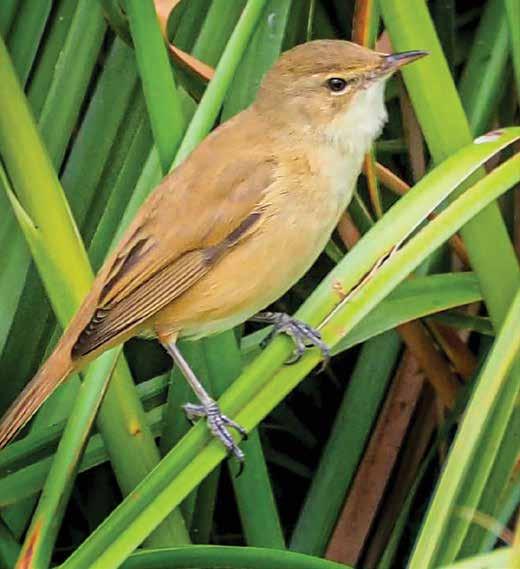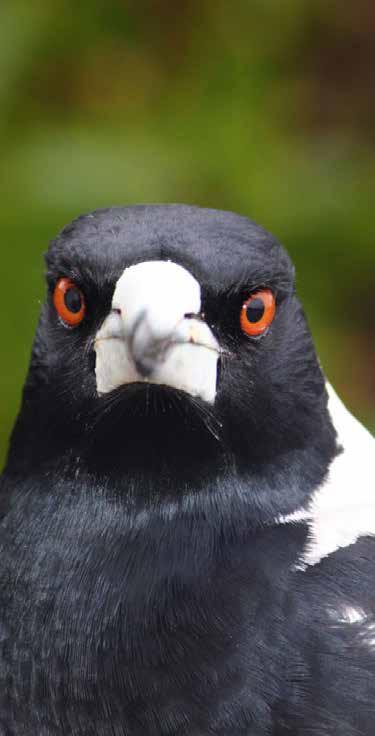
4 minute read
Nature
reasonably common birds on Bribie Island living mainly in reeds at the edge of waterways. By: Marj Webber
They are small Old-World Warblers (sometimes referred to as true warblers) around 17 cm in length and weighing only 12-23 g. They are slim passerines with olive-brown backs, creamy underparts, tawny rumps and are not streaked like Grassbirds or Cisticolas. Inside their mouths is yellow and obvious when warbling amongst the reeds. Small spiky crests on their heads are sometimes visible. They are hard to spot as they tend to remain mostly hidden but their loud tuneful call resembling that of the Brown Honeyeater will betray their presence if they are about. When perched or moving about they cling to the reed stems. Both males and females are similar in appearance. They are likely to be found throughout most of Australia where there are reed beds in fresh or brackish waters. Sometimes they appear in clumps of lantana and bamboo. Some populations seem to be sedentary but mostly they are migratory, moving for fresh food or south in the summer to breed. More is yet to be learnt about their migratory habits, particularly of those in the north. Australian ReedWarblers are also residents of PNG and islands across the Indian Ocean to South Africa.
Advertisement
Food is obtained mostly from the ground amongst the reeds and consists mainly of insects, but sometimes seeds and molluscs are added to the menu. Usually, they forage singly but sometimes form pairs.
Australian Reed-Warbler
Acrocephalus Australis
Breeding takes place usually from September to February. Males arrive early to the site to establish their territory. During the courtship, males are extra noisy and warble to impress the females. They build flimsy nests which are believed to be part of the mate selection process. Reed-Warblers are monogamous for one season and probably select a new mate the following year. Well hidden, cup-shaped nests of grass and reeds are built by both parents 1 m or less above the water supported by 3-4 reed stems and attached cleverly with fibres tied around reed stems. Nests are deep and narrow towards the opening at the top, so eggs and babies don’t fall out during strong winds. 3-4 spotted bluish-brown blotched eggs are laid and incubated by the female for 14-15 days. Both parents feed the young birds. After 14-16 days the young leave the nests but continue to be fed by the parents till around 28 days. The scientific name Acrocephalus meaning “Topmost Head” in Greek refers to their short spiky crest. Australis in Latin means “Southern”.


Australian Reed-Warblers have only about 58% nesting success when breeding. Some of their threats are from predators when nesting and burning and human interference of their habitat. Their conservation status is listed as least concern.
MAGPIES ARE FAMED FOR THEIR INTELLIGENCE AND NOW A “FAILED” EXPERIMENT BY RESEARCHERS AT THE UNIVERSITY OF THE SUNSHINE COAST HAS SHOWN JUST HOW CLEVER AND COLLABORATIVE THE AUSTRALIAN SONGBIRD REALLY IS.

small group
Aof feathered masterminds foiled a project trialling a novel harness design, which allowed GPS tracking devices to be strapped to the backs of magpies (Gymnorhina tibicen), by helping each other quickly remove the devices. Dr Potvin said the way the magpies teamed up to escape from the harnesses was unexpected. “This shows high levels of cognitive ability and also cooperation – helping others seemingly without getting a reward,” she said. “This kind of ‘rescue’ behaviour has only been documented in a handful of birds and is a remarkable indication of tight social structures and relationships.” Mr Crampton, who helped conduct the study as part of his honours research, said that despite previous tests demonstrating the strength and durability of the harness, the birds managed to remove the devices within minutes to hours of the initial fitting. “To our knowledge, this is the first study to report the removal of GPS trackers within members of the same species and should be considered when planning future tracking studies, especially on highly social species, such as magpies,” he said. The pilot study involved five birds and got off to a good start, with the researchers initially hopeful it could be replicated on a larger scale. “We first trained the magpies to come to the feeding station, then caught them and put them in the special harnesses containing the GPS tracking devices,” Dr Potvin said. The idea was for the harnessed birds to later return to the feeding station, where a magnet would release the GPS device without the need to catch them again. “Of course, every time you put a tracker on a bird, it takes a bit of getting used to, so the magpies were adjusting and turning their heads to try to grab it,” Dr Potvin said. “But the harness isn’t accessible by the birds. Well, by themselves. We didn’t count on them asking for help from each other.” Within the hour of the last tracker being placed on a bird, the researchers witnessed an adult female pecking at the harness of a juvenile, eventually managing to release it. “This is quite a feat because there is only one weak point on the harness, which is where it would have been released by the magnet,” Dr Potvin said. A few days later, none of the five birds, even the dominant male, still had their harness on. The researchers said the behaviour demonstrated both cooperation and a moderate level of problemsolving, providing potential further evidence of the cognitive abilities of this species.











